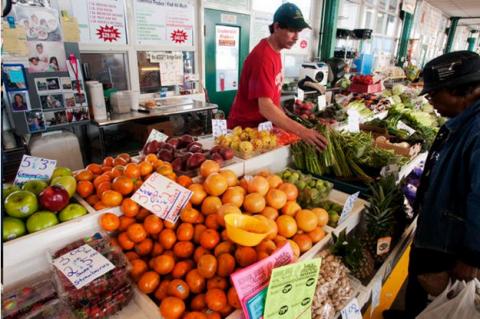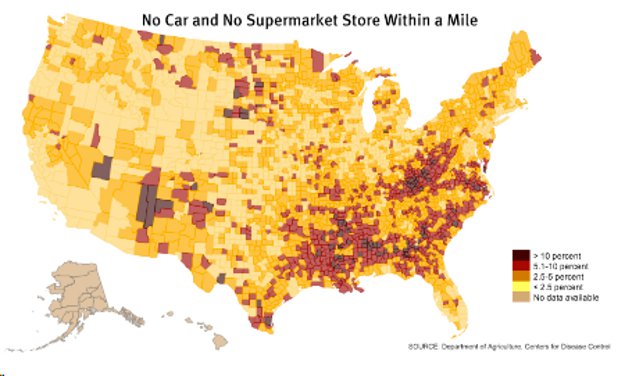Are ‘Food Deserts’ a Myth or Simply Misidentified?

There is an idea that, while it’s been around for at least a couple of decades, has recently become entrenched in the discourse of the food craze sweeping the nation. Even with rising obesity rates, it may seem like a strange concept that many Americans still do not have easy access to healthy foods, or food in general. This singularity has been coined in the term “food desert.”
The name “food desert” was reportedly first used in Scotland in the early 1990s, when the Scottish government was conducting a survey and published its findings while working on a policy called “Nutrition Task Force.” Academics and policy makers, prompting a dialogue of the problem at hand, have since used the term more widely. The U.S. Department of Agriculture (USDA) defines a food desert as a low-income community in which the nearest supermarket is at least one mile away from a populated zone. This infers that zones deemed “food deserts” would have limited access to healthy foods without the burden of inherent hardships, such as ownership of car or access to public transportation to reach the nearest supermarket.
Perhaps not surprisingly, the areas that show more occurrences of food deserts are rural, where long distances are the norm and are generally sparsely populated. However, a number of glitches arise because the definition of a “food desert” may not necessarily cover all its bases. In rural areas, for example, car ownership is a common facet of its lifestyle; so even if supermarkets are farther away, people usually have access to reliable transportation. There is also the classification of a food item as “healthy,” and what that means to the populace in general. As it is, it seems that even when given access to supermarkets, there are other important factors that take part in the purchasing patterns of the population. Cultural background and level of education play much bigger roles, especially in historically underserved neighborhoods in urban areas.
In 2011, the U. S. Department of Agriculture revealed a location based interactive map to identify and track the insurgence of food deserts across the United States. It estimated that approximately 23.5 million Americans live in a food desert. The map further identified a few sectors in New York City as food deserts, including not only sparsely populated zones (such as near the NYC airports), but also densely crowded neighborhoods like the Morrisania section of the Bronx.

Presently, the USDA map does not identify a single section of New York City as a food desert within the initial parameters for the classification, though it does show a few isolated spots if the search query is changed to show areas where the closest supermarket is at least a half-mile away (approximately 10 street blocks). This is due in part because of a citywide tax incentive program to build supermarkets in underserved neighborhoods of New York. Federal aid is also promised in the form of tax incentives, perhaps more prominently from First Lady Michelle Obama’s keystone “Healthy Food Financing” initiative.
Also back in 2011, a study was published stating that there is no connection between proximity of access and healthy eating habits, using at least 15 years of data. A similar study in 2012 reached more or less the same conclusion, having focused in middle-school aged children in California.
Nevertheless, among the growing evidence that vicinity and eating habits may not have that much of a correlation, a supermarket opened in the Morrisania neighborhood of the Bronx in late 2011, under the city’s “Food Retail Expansion to Support Health” (FRESH) program. The neighborhood then became the focus of another study conducted by the NYU Langone Medical Center, which would compare the food shopping and eating habits of the Morrisania population with another neighborhood one mile away, with systematically identical demographics.
Published in February of this year, the study arrived at the same deduction as its predecessors: the eating habits of the Morrisania neighborhood had not changed despite the presence of a new supermarket offering healthy substitutes and standard prices, at least in short-term practice. The study also mirrored the conclusion that there are much more powerful variables that determine any given choice of diet, such as education, ethnic background, and cost of food.

Interestingly enough, the USDA found in 2009 that poorer neighborhoods have, in fact, more supermarkets on average than richer neighborhoods (with a few notable exceptions such as the Morrisania, of course). How, then, can a food desert be properly defined?
In order to understand this, it seems it is necessary first to come to terms with the fact that necessity will always trump convenience, and second that the circumstances of an individual or a family are valid and strong motives that shape the decision making process. The studies mentioned above looked at broader societal influences that play a role in individual eating habits, such as workplaces, food marketing, and government policies, more so than just the cost and availability of food. Far more predictable than the shopping habits of a community given the proximity of a supermarket, were of those with high-school level education and college-level education. Researchers found that low-income, low-education individuals living in richer neighborhoods, with even more access to healthy options, opted still to buy the same kind of food as their counterparts in poor neighborhoods.
It is also crucial to note that underserved areas are historically Black and Hispanic neighborhoods. This is because culture itself seems to be of vital importance when defining eating habits. Soul food, for example, with its undeniable centrality to Black culture, can be traced back to the slave trade from Africa to the United States. Deeply rooted in slavery and sharecropping, during which time slaves often had the cheapest possible way of nourishment such as weeds and discarded food items like ox tails, pig feet and ears, and offal, the preparation of soul food regularly employs salty and greasy ingredients, born more from the necessity of preserving food and downright lack of options.
Likewise, Hispanics have an eclectic mix of cultures in their cooking. Partly taken from the indigenous agricultural practices of grains and herbs and the tropical crops of the regions, Hispanic cuisine is laced prominently with Spanish, Italian, and Portuguese influences. Furthermore, as with soul food, there is also the impact of slavery in Latin America; perhaps just as rampant but less documented, it is estimated that twice as many slaves arrived on the coasts of Mexico and Brazil than the United States starting as early as the 16th century.
This conglomeration of cultures gave rise to the conventional use of red meats, starch, and salted ingredients found throughout Hispanic cuisine. It has been noted, for example, that authentic Asian cuisine, which includes a high intake of unsalted rice, is healthy and fulfilling. While an equitable amount of rice is consumed in Latin American cuisine, it is almost always salted—effectively slowing down the release of at least some of the starch from the grain (this is one of the reasons rice in Asian cuisine is sticky, while it is usually loose and dry in Latin American foods).

This predisposition to ethnic cuisines may simply be an attempt to stay connected to an individual’s roots. In a nation of immigrants and foreigners, the desire to maintain at least a semblance to someone’s homeland can hardly be faulted. It may also be, however, that the ingredients to make these foods are cheaper to buy and quicker to prepare. A glazed wild salmon with a side of steamed organic broccoli sounds like an ideal dish for dinner. But even if salmon, wild or otherwise, may no longer be reserved for special occasions and holidays given its rise in consumption popularity (a lox bagel is a staple New York City food after all), the truth of the matter is that it remains out of reach for many, especially in underserved neighborhoods. An estimated 43 million Americans live on the Supplemental Nutrition Assistance Program (SNAP – formerly known as “food stamps”). SNAP provides an estimated $1.40 per meal, per person. The proximity of the supermarket, then, seems irrelevant if a mother of three cannot afford a bunch of kale and will instead opt for cheaper, frozen, and over-processed alternatives.
There has been a significant push to tweak the way in which underserved communities consume food. Wilber Jones’s “The Healthy Soul Food Cookbook” is a great first step toward a healthier lifestyle without giving up the unique traits of a culture. But it is imperative to understand that healthy eating habits (and all the ramifications that would cause, like lowering obesity rates) need to be formed by tackling more pervasive issues than proximity to a food cart. Proper handling and distribution of government funds, educating the masses, and a clear and sympathetic grasp of cultures and circumstances may, in the long term, do more good than just labeling a community a “food desert.”
Author Bio:
Angelo Franco is Highbrow Magazine’s chief features writer.






























































































































































































































































































































